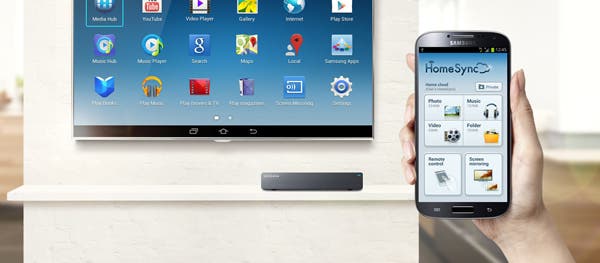Spec Analysis: Samsung Galaxy S4
Out of this world?
Update: According to Eurodroid, Samsung won't be releasing the 'international' version of the S4 in the UK, as it did with the S3. Instead it gets the same unit as North America, featuring a quad-core Qualcomm Snapdragon S600 processor. This one runs at 1.9GHz, offering a useful performance boost over a slower rendition of the same chip found in the HTC One. Leaked Geekbench results suggest that this has twice the raw processing power of the iPhone 5 and a good 84 per cent increase over the older Galaxy S3. Meanwhile, GLBenchmark results attributed to the Qualcomm-based S4 show GPU results almost 150 per cent higher than the S3, and a 22 per cent boost over the Nexus 4. How it compares with the Exynos Octa derivative we discuss below remains to be seen...
Original Story: According to Samsung, it managed to sell 40 million Samsung Galaxy S3s in just six months. Compared to a ballpark 80 million Xbox 360s across seven years, this puts into perspective just how huge the smartphone market is and how successful the Korean firm's offerings are - suffice to say that the iPhone mega-brand is finally up against some serious competition. Last week, the S3's successor was revealed and the specs are extraordinary. When it launches, the Galaxy S4 will almost certainly be the most powerful smartphone money can buy.
Taking centre stage is the new Samsung Exynos 5 Octa processor, combining an impressive range of processing components. First and foremost, as the name suggests, the chip features eight CPU cores - unprecedented for a mobile device. However, it's important to point out that only four of them are ever active at any one point. The CPU is based on ARM's new big.LITTLE architecture, which aims to address a fundamental issue with its new A15 technology - the fact that it's a little too power-hungry for a smartphone-sized device. ARM's solution is ingenious, the firm pairing up each A15 core with a smaller, less capable but more power-efficient A7 core. The two cores share the same instruction set and can run the same code, with the device switching between them according to load. This core-juggling is all handled by the chip itself, with the OS recognising the CPU simply as a standard quad-core part.
Now, the usual form for power-saving is pretty straightforward - clock-speed scales according to CPU requirement - but we get the feeling that the conventional approach didn't produce the results ARM wanted. The A15 is an advanced core, occupying a fair amount of silicon and even on low clocks, the power usage was likely still too high. The A7 operates in a similar manner to the smaller, fifth "companion" core found in the Tegra 3 chip from Nvidia, smaller and simpler in nature, less powerful and more geared towards less demanding tasks. The notion of pairing such a core with each of the larger A15s is certainly ambitious and won't be cheap - Samsung is clearly investing heavily in making sure that the Galaxy S4 has the same kind of decent battery life as its predecessor.
Power in perspective
So just how much power does a quad-core A15 running at full pelt offer? Recent analysis of the iPhone 5 dual-core CPU put into perspective just how meagre mobile processing power is generally - the Motorola Razr I features an Intel Atom core virtually unchanged from the one that powered the netbook craze of a few years back, and in most benchmarks it was easily the best performer across a range of top-tier devices. In effect, a five-year-old low-power CPU that in turn matched the performance of a 10-year-old desktop processor was faster than the iPhone 5's CPU.
Anandtech's recent Atom vs. A15 testing shows progress though, with the Exynos Dual (utilising two A15 cores) showing a 40 to 65 per cent increase in performance over the single-core Intel part. Doubling CPU cores doesn't typically offer 2x the performance, but the fact is that with the quad-core A15 found in the Galaxy S4, we should be seeing a massive increase over the Atom and thus, by extension, the iPhone 5 - the S4's major competitor.
The CPU component isn't the be all and end all of the Exynos Octa though - it's evident that Samsung hasn't skimped on the graphics processor either. The move to a display as pixel-rich as the S4's five-inch 1080p screen requires a suitable level of GPU grunt to keep things running smoothly. IMG Technology's PowerVR SGX544 gets the nod here - the same processing technology found in a four-core configuration in the fourth generation iPad. With fewer pixels to address, Samsung has opted for a tri-core configuration of the part in the S4. Bearing in mind that it's dealing with around 30 per cent fewer pixels, overall graphical performance should be pretty close between the two devices and definitely very competitive against the iPhone 5.
"In addition to the octo-core CPU set-up, the S4 features the same powerful GPU technology found in the iPad 4."

Overall, then, the two main processing components in the new Galaxy S4 look very strong indeed - state-of-the-art, even. How Samsung has achieved this comes down to two defining factors. Firstly, there's the move to a 28nm fabrication process for the Exynos Octa - smaller chips are cooler and more power-efficient (in comparison, most of the newer flagship smartphones are currently at 32nm). Secondly, the basic form-factor of the Galaxy hasn't changed that much compared to its predecessor - it's still a large device, allowing for the inclusion of a 2600mAh battery, up from the 2100mAh cell in the S3 and much larger than the 1434mAh example found in the iPhone 5.
441ppi 1080p screen aside (though the Xperia Z and the HTC One both beat Samsung to the punch here) other refinements are thin on the ground, leading many to dub the new phone the "Galaxy S3S". The overall form factor of the device is indeed much the same as the S3, with a similar level of build quality - if you weren't keen on the plastic finish of the last phone, little has changed here.
Despite the larger battery, the device is a touch smaller - 0.8mm has been trimmed off the width, while thickness shrinks from 8.6 to 7.9mm, shedding 3g in weight into the bargain. Memory speed and bandwidth has also improved, with Samsung transitioning across from 2GB of LPDDR2 to the new LPDDR3. Samsung is offering a new 64GB SKU in addition the established 16/32GB configurations, but retains the microSD expansion options on all models.
The onboard cameras also see significant improvement with the rear snapper transitioning across to a 13-megapixel sensor and the front-cam moving up to a decent 2 megapixels - that should be good for 1080p30 movie capture. The specs are backed up by additional functionality: Samsung debuted what it calls "drama shots" - multi-shot composites showing object motion composited into one image - plus there's "story album" mode, allowing you to lay out basic albums of shots with appropriate captions. There's even a function to capture from both cameras simultaneously, so prepare for a new craze of mobile photography with picture-in-picture reaction gurning from the owner.
"There's a vast level of raw power in this new handset, but we get the sense that Samsung doesn't quite know what to do with it."

Customised Android 4.2.2, TouchWiz enhancements, new media functions
With the technological credentials of the S4 seemingly beyond reproach, the question is what Samsung intends to do with it. Firm answers seem thin on the ground, though last week's press conference showed off a number of new features. Android 4.2.2 powers the device, bringing with it the latest iteration of the Korean giant's TouchWiz interface.
Superficially it looks much the same as the S3's rendition, but there are a number of cute enhancements, specifically finger-tracking that allows you to swipe around the interface without actually touching the screen - and apparently you can even answer calls in this way. The eyeball-tracking Smart Stay tech, which tells the device whether you're looking at the display or not, is improved with video now pausing when you're not looking at the screen.
Media playback in general gets a significant boost, with the ability to stream media to other devices via AllShare, while there's even the bizarre ability to network multiple S4s together to play the same music - "a powerful sound system that enhances the sound quality and keeps the party going" - as Samsung puts it. On a more practical level, the device is clearly very forward-looking: decoding hardware includes support for HEVC (High Efficiency Video Coding), the successor to the h.264 video compression standard used now.
Gimmick features aside, the reveal of the S4 looks like a powerful statement of intent from Samsung - an outright technical assault clearly designed to seize market leadership in the high-end smartphone market. Short of a transition to the game-changing PowerVR 6-Series "Rogue" graphics chipset (now due later in the year), it's safe to say that there's not really much more Samsung could have done to make the Galaxy S4 any more powerful than it is. Exciting stuff, then, and we'll be looking to fully review the new device closer to its launch at the end of April.








